
Option’s 30th Party

Tuesday, November 2, 2021
Deep Ellum Brewing Company,
Tyler Station


Deep Ellum Brewing Company,
Tyler Station

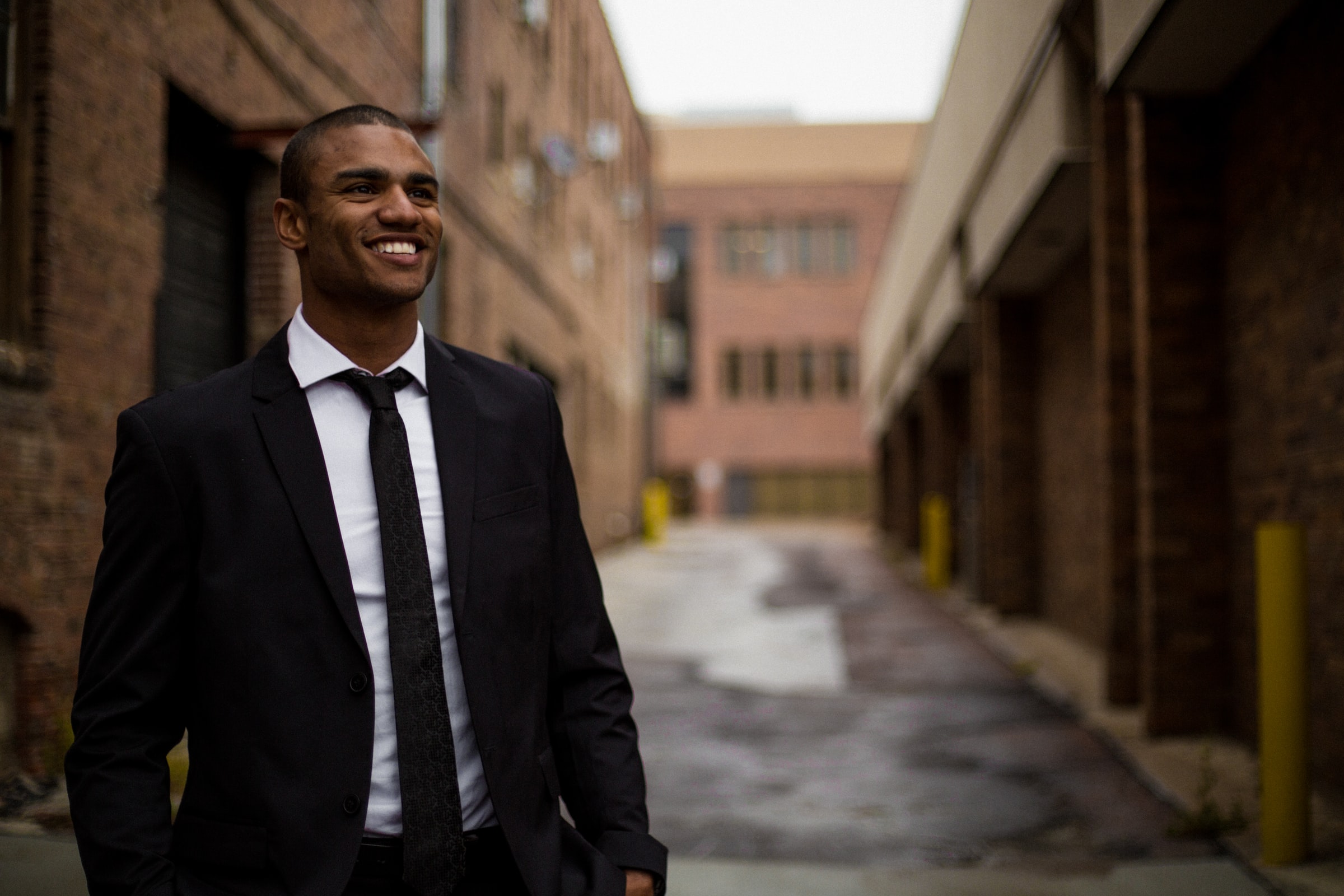
Whether leasing office space for the first time or moving to a new location, the process of assessing space needs, creating a budget, touring space, and moving can be daunting. One of the elements that makes leasing space so challenging is that there is no universal lease, nor standard building. The good news is that even though the particulars of the leasing journey will differ for every tenant, the general path each must follow is very similar.
Below, we’ve summarized five major steps in the leasing process. Those steps include:
1. Understand Leasing Process.
2. Assess your space needs.
3. Develop a budget.
4. Select a location and a building.
5. Move in!
By understanding the steps in the process and how much time each can take, you can set realistic expectations about the amount of lead time required for you to procure a new location. Small blocks of 500 square feet may take a few weeks to button down, but larger blocks of 5,000 square feet or more may require months to secure and build out to your company’s specifications.
There are a few critical activities to carry out during the early stage of the search. For the most part, these tasks involve time, focus and organization rather than an outlay of cash. They can be completed concurrently and will take between one to six months to complete.
A company’s stage of life is often a good guide for determining why, or even if, a company needs a space. A nascent business looking to move out of the founder’s house might consider a coworking or executive suite arrangement. An established business may be growing, so a larger office suite or an additional office in a different location might make sense.
Understanding the needs of the key people involved with your business is very important. So, determining if there is a client base you need to be close to or if employee commuting patterns are a priority is a good place to start. Do you want to be located close to public transit or major highways? These are just some of the considerations you will need to attend to when assessing locations and buildings.
Figuring out how much space to lease and how the office will be laid out is an important early step in the process. To get started, conducting a back-of-the-napkin calculation can help you generate a reasonable estimate. To accomplish this, multiply the number of employees you need to accommodate by the average number of square feet per worker in the U.S. According to CoStar, this figure currently sits at around 190 square feet for an office use.
So, if you have 6 employees that will each need their own desk or office, you will likely need 1,140 square feet. This figure will rise or fall depending on a host of factors, such as conference rooms or a kitchen that your firm may require; if you will need more offices than cubicles; if you will create a reception area; the column spacing and window line of the buildings you are considering, etc.
Understanding how much you can afford to pay in rent is critical. Here again, a back-of-the-napkin calculation can help generate a decent approximation. Continuing with the example above, if you lease 1,140 square feet and pay $22 per square foot per year in rent, your monthly rent will be $2,090.
Concerning the $22-per-square-foot figure, you will need to be clear about whether a space is being offered on a full-service or a triple-net basis. The former means that all taxes, utilities and management fees are included in the rent and the latter indicates that you will pay for those expenses in addition to the $22 rent figure. We offer both, depending on the building. Also, those operating expenses can vary widely, anywhere from about 5% to 25% of the base rent.
Remember, if you are looking at a space with a NNN asking rent, you have to factor in all of these additional costs to “gross up” the rent to be equivalent to the other asking office rent types: “net of electricity” or “full service gross.”
Spaces that generally quote by a “net of electricity” and “full service gross” amount include the NNN base rent, plus the operating expenses and janitorial services. The only difference in a “net of electricity” lease is that the tenant pays separately for electricity. Universally, rents quoted on a net of electricity or full service gross basis are more expensive on the surface, but since they include all of the additional cost elements, they may not be as expensive overall relative to a NNN equivalent.
For overall context, here’s a list of the major upfront expense items to consider when searching for a space. They are organized into three broad categories: lease-related expenses, construction-related expenses and move-related expenses.
In addition to considering where your employees live, you will also want to evaluate where your customers are located. This factor will be particularly crucial for customer-facing organizations, such as retail or medical tenants, but it will also notably impact professional services tenants, including hair salons or . This element also needs to be appraised in reverse; perhaps your company doesn’t host its clients very often, but your employees frequently visit their customers. As with your employees, conducting an analysis of customer zip code information can reveal the most convenient locations for your business from a client perspective.
Commercial leases typically cover long periods of time. During that kind of interval, a lot can change for your business. For this reason, we offer greater flexibility than most companies, flexibility that can be critical when evaluating a potential property. You’ll want to be assured that you’ll have the ability to grow or adapt.
Notifying clients, filing certificates of occupancy, determining what furniture to keep, purging old files and ensuring that the lights are on at the new office location are all components of a business move. This is the last step in the process after searching, touring, calculating costs, and possibly constructing. While the steps involved in moving may seem intuitive, it is important to plan for the move and set expectations, especially among any employees. Being prepared for each phase of the process will ensure you are open for business in your new location.

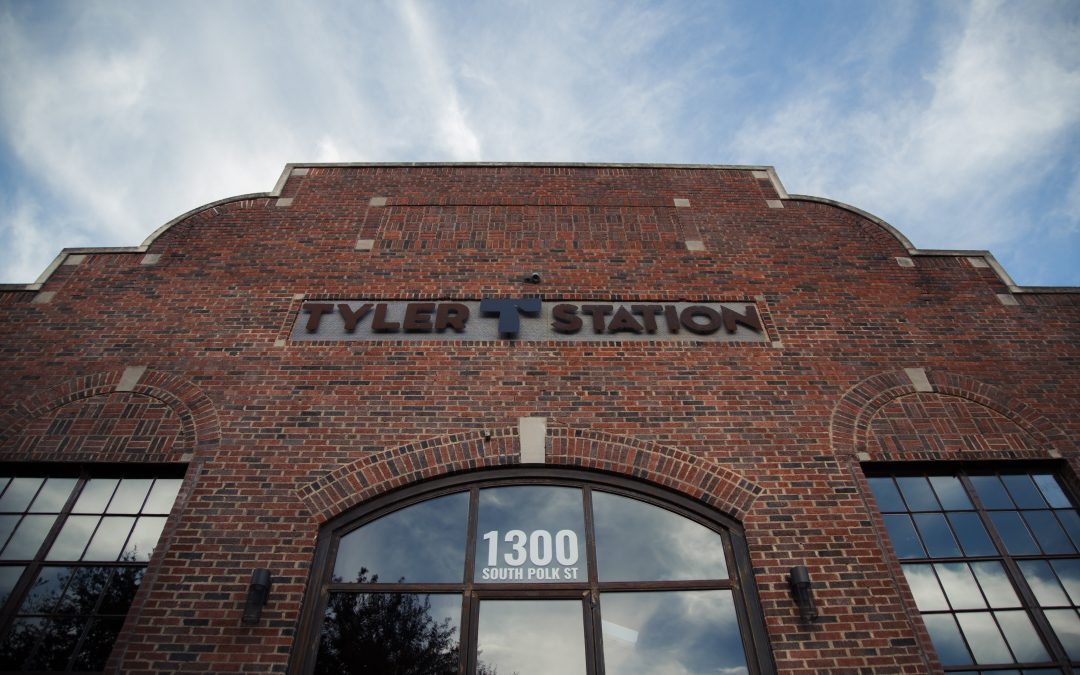
Visitors to Dallas quickly hear about the Bishop Arts District, an espresso-and-hip-boutique retail area located in rough (but gentrifying) Oak Cliff. What they’re usually not expecting to find when visiting the neighborhood is a building called Tyler Station, a 100,000-square foot remake of the former Dixie Wax Paper factory. The site houses some 70 small businesses in what Southern Dallas County developer and human connector, Monte Anderson, calls “a collaborative village.” It’s a prime example of what’s known as incremental development.
Artists, makers, and entrepreneurs productively “collide” here — as Anderson likes to put it — in dizzying variety: A co-working space (Wax Space); a martial arts studio (Oak Cliff Aikikai); Oak Cliff Brewing; Crumb & Kettle bakery; a barber shop; a tea store (Zakti); tattoo studios; and an event space (Place at Tyler). “We also had a hippie Baptist church for a while,” he notes, “and now we have the studio of an African American author of what she calls ‘gangster love’ novels — over 100 of them.”
Inside is a vast, high-ceilinged honeycomb of retail spaces constructed with repurposed wood and metal cattle panels so as to allow visitors to look in or chat with a business owner. It’s a large and inviting space. Many colorful events have been held including a Juneteenth Festival, a diaper party, grand openings, Origami Saturday, The Color of Ideas lecture series, community meetings, and much more. Inside is a vast, high-ceilinged honeycomb of retail spaces constructed with repurposed wood and metal cattle panels so as to allow visitors to look in or chat with a business owner. It’s a large and inviting space. Many colorful events have been held including a Juneteenth Festival, a diaper party, grand openings, Origami Saturday, The Color of Ideas lecture series, community meetings, and much more.
Another thing you notice: Quite a few of the tenants Anderson signs up are small, often minority-owned enterprises launched by people from the immediate area — and on shoestring budgets. As he describes the grassroots feel of Tyler Station, he pauses to add, “You get that this is not about real estate, right?”
A native of Southern Dallas County himself, Anderson is the founding and past president of the North Texas chapter of the Congress for New Urbanism, and a co-founder of the Incremental Development Alliance, a non-profit aimed at coaching small-scale, “missing middle” housing developers and an advocate of resident-driven neighborhood development. He is also a former motocross racer who barely made it through high school, as well as a remarkable social entrepreneur. His numerous real estate developments include a boutique hotel which was key in sparking the Oak Cliff comeback story.
Anderson explains, “Tyler Station is just like what we’re going through now nationally with converting all the big box places, the office centers. We have to figure out how to scale down the rent to a point which is low enough for the area, while still high enough per square foot to make the project sustainable.” Which for Anderson means without subsidies and all the usual strings attached.
“We bought Tyler Station in 2016 for cheap — nobody wanted it. There was environmental contamination, it needed a $750,000 roof, it was full of smokestack equipment and dead raccoons.”
About that time, he decided to partner with Stash Design, a successful studio which specializes in sourcing found and salvaged objects for clients wanting a green-but-stylish look. Taking 20,000 square feet, Stash Design became the project’s anchor tenant and minority partner.
Yet, the partners did not go into the project with a clear marketing plan. “I thought we would put in a bunch of industrial users, a bunch of makers. But that’s not who showed up,” Anderson says. “It’s like when you’re first cleaning out the building, and then the more you see, the more your ideas change. We just wanted to let the building tell us what it wanted to be.”
He takes his hands-on approach a step further. “I want to teach people how to fish, as they say — but to do that, you have to spend time with them. I work mostly with the folks who are trying to scrape up $250 a month. I let my staff handle the regular business conversations back in the office. Where I’m needed is out in the trenches, feeling it, tasting it. For me, success is watching other people learn to do things — making it their own.”
Toward that goal, Anderson is known for making personal low-interest or interest-free loans to entrepreneurs and cutting deals on the rent. “Here’s an important thing — the majority of our tenants are close by here and from southern Dallas, which has some of the poorest neighborhoods in the country. This is exactly what we wanted to see. We wanted to impact the immediate area first, to give them opportunities.”
Translating that goal of localism into a phrase, Anderson simply advises. “Farm where you are.”
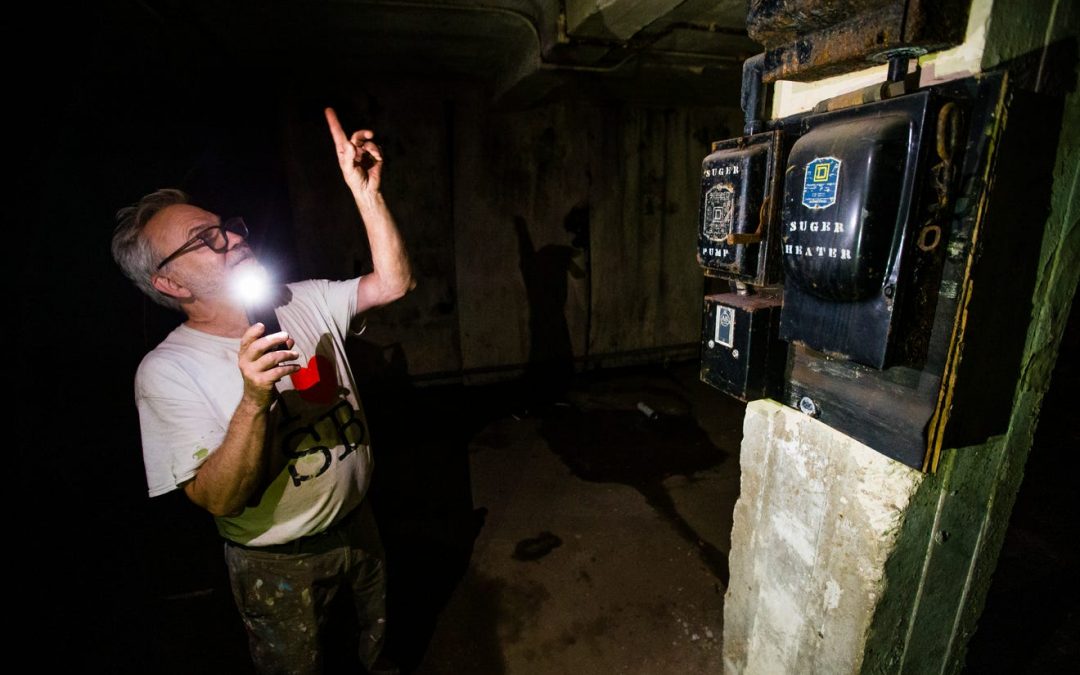
SOUTH BEND — With his hand, Mike Keen brushed flaking paint from a column of pearly white ceramic “subway tiles,” saying, “This can’t rot.”
But, below his feet, the original oak floor had already rotted and been removed, thanks to a roughly 6,000-square-foot hole in the roof that had let rain and snow collect inside of this vacant former bakery at 906-910 Portage Ave., just over a half mile from downtown.
Sprawling piles of garbage were removed this year. Keen could now see across 56,000 square feet of often dark, dank, open floors. He saw past the puddles and mildewed arcade games littered in the basement.
Those tiled walls could become part of the new storefronts on Portage. Windows could again appear in their bricked-in spaces of the historic former Ward Baking Co.
“We’re really trying to create life on the street,” said Keen, managing partner of a group whose goal is to turn this into a nest for up to 60 businesses, artists or organizations in three years.
At an estimated total cost of $3.75 million, the development’s biggest challenge now, Keen said, is finding the bank financing and the first possible tenants “when this is the best that it has looked in a decade.”
“You have to have the vision and the patience to see that, in the beginning, you’re going to have almost no impact,” he said.
Banks, he said, like to feel confident that such a project would land tenants. That may be easier for buildings designed for just two or three tenants, but that wouldn’t fit the vision of what Keen and his project partners aim to do. They want to draw together a collection of small and larger enterprises that could feed off each other and bring life to a previously stagnant area that Keen calls Portage Midtown.
Across Portage, there are homes that he’s renovated and two 600-square-foot “tiny houses” that he and partners built this spring (with hopes for more in adjacent lots), plus the weekly South Bend Bike Garage co-op that bustles with volunteers each Wednesday evening. It’s all a few steps from the Near Northwest Neighborhood Center and its coffee shop.
Keen, a retired IU South Bend professor who lives nearby on Riverside Drive, joined his Ward project partners in an LLC they call The Bakery Group: local architect Greg Kil, Borkholder Buildings owner Dwayne Borkholder of Nappanee and Dallas real estate developer Monte Anderson.
They began cleanup and roof repairs in February. Keen hopes that, if the windows and storefront doors can be installed early in the process, they’ll inspire banks and the public to see how engaging the structure could be.
The city has discussed allocating tax incremental finance dollars to help with the windows and doors along with other ideas, such as an outdoor plaza here and improvements elsewhere in Portage Midtown, said Santiago Garces, the city’s executive director of community investment.
Garces said the city is looking at this and other corridors and how to “reactivate” such neglected mid-town spaces so that they draw people from their neighborhoods and even from the region.
Keen said The Bakery Group’s goal is to repair the building enough so that, in the first year, it could gain an occupancy permit and move in 10 to 15 tenants — or about 30% occupancy — then 70% in the second year and 100% in the third year.
They would build it out one section at a time, structuring it according to what the tenants want, he said.
Initially, Keen wanted to knock the Ward building down so that there’d be eight vacant lots to develop or build homes, but Anderson convinced him otherwise and offered to become a project partner.
“Monte said this was too beautiful of a building,” Keen recalled.
It reminded Anderson of Tyler Station in Dallas, a former wax paper factory, built in 1925 next to a train station, that he turned into a co-working space, now filled with a brewery, fabricators, retail shops, artisans, attorneys, churches, filmmakers, martial arts, wellness instructors and others.
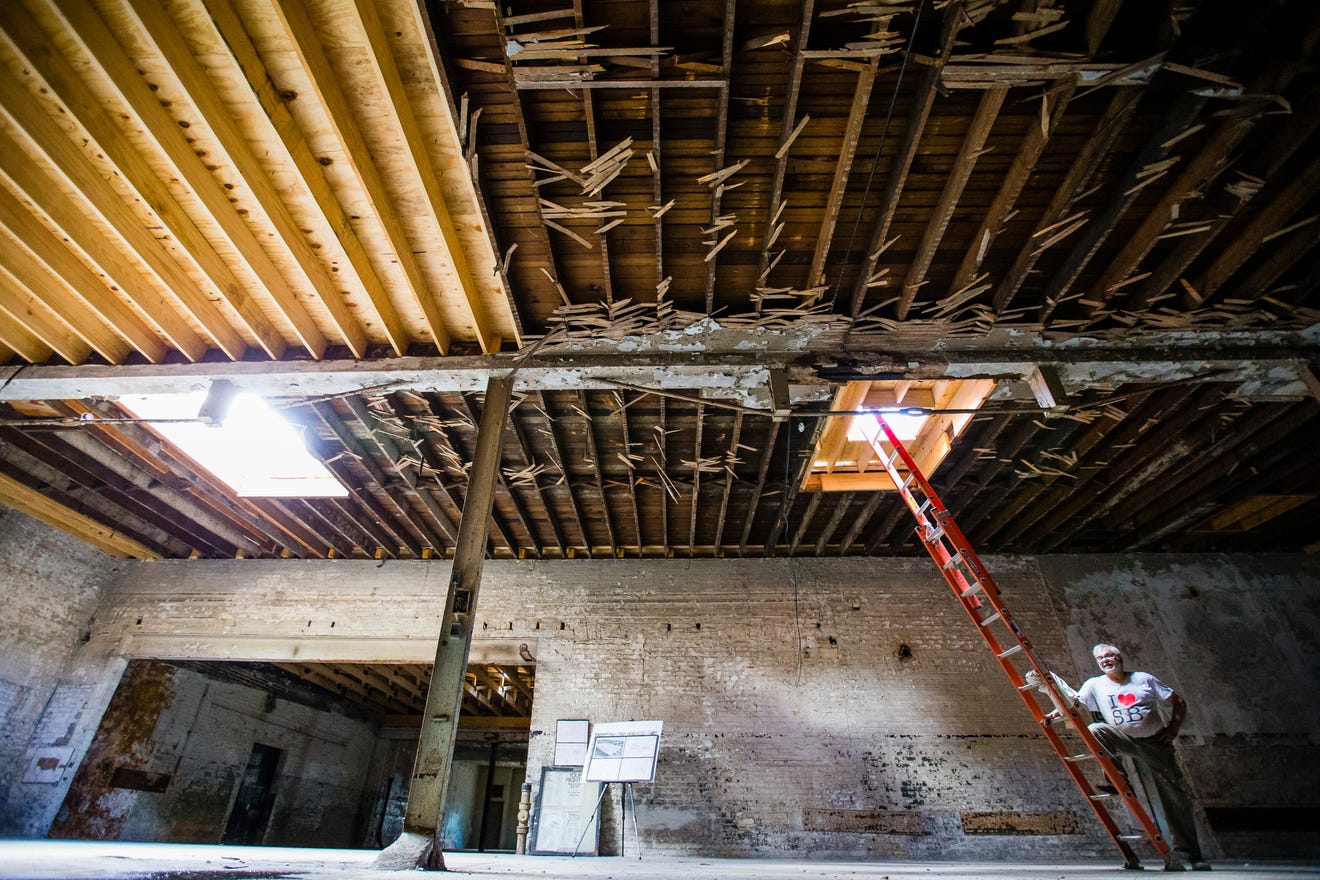
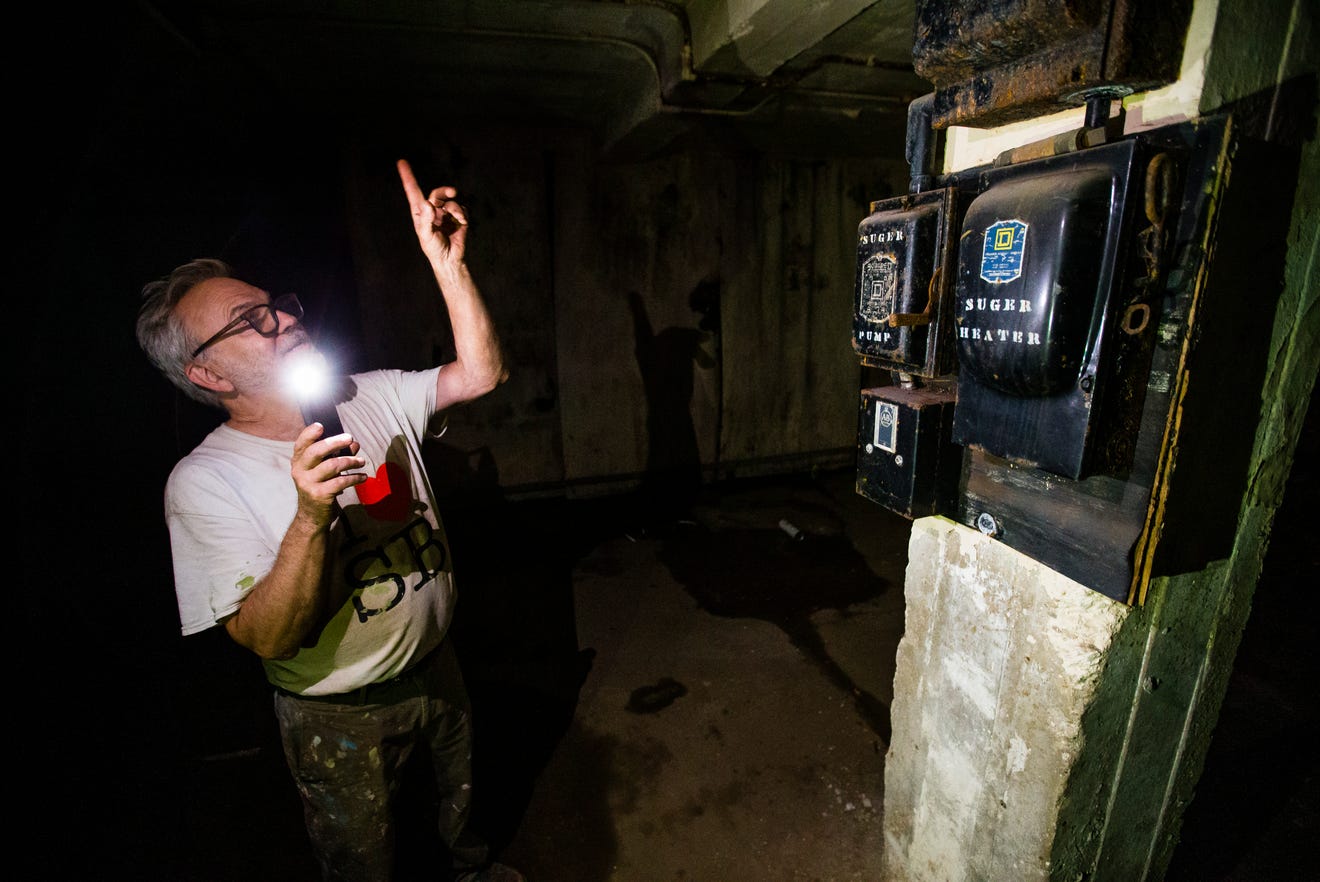
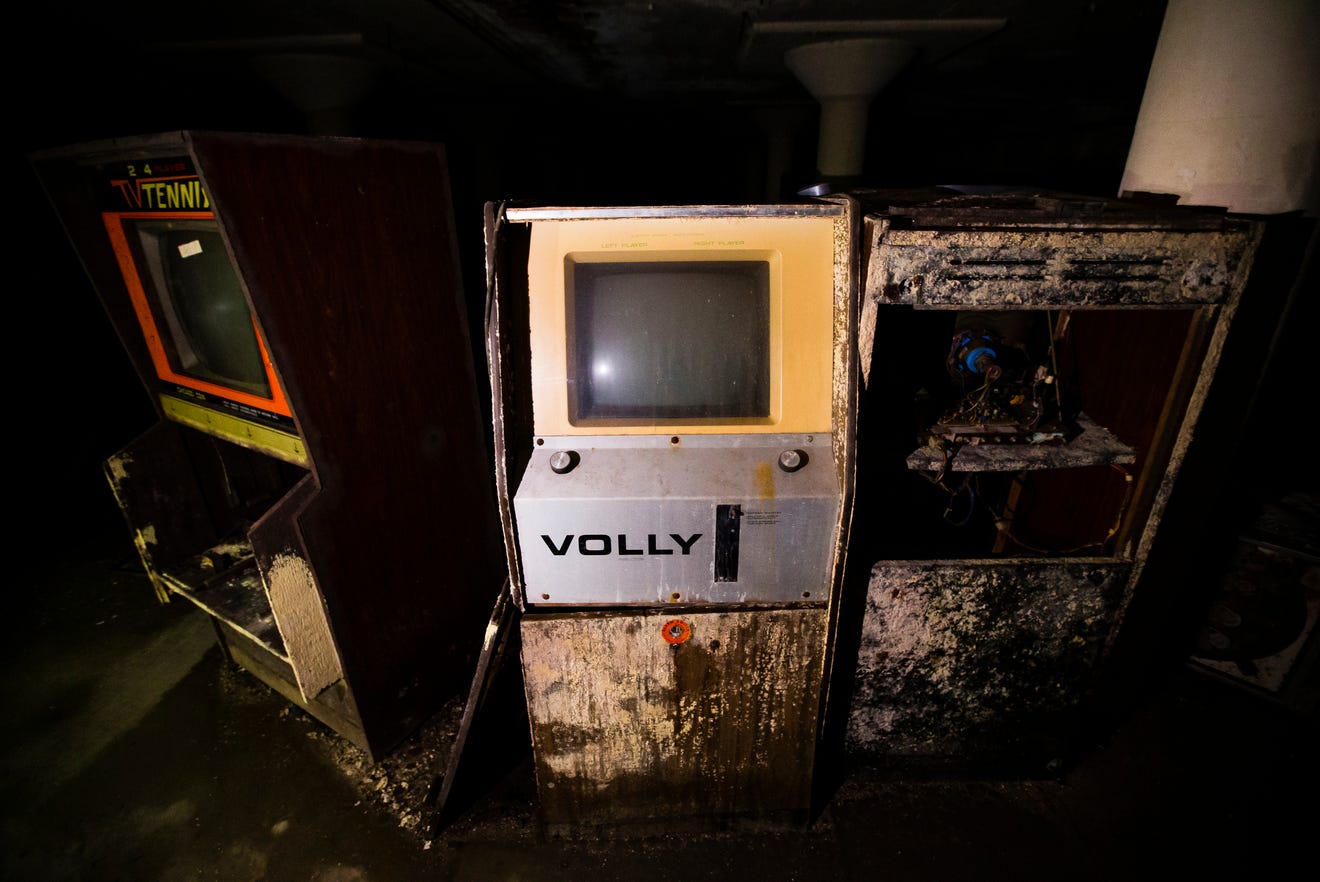
It’s an example of incremental development. The idea is to build wealth in a neighborhood one piece at a time through small-scale projects. Anderson, who is a founding member of the nonprofit Incremental Development Alliance, has been coaching and mentoring Keen and other aspiring developers in South Bend in recent years, Garces said.
Likewise, Keen hopes for a mix of tenants in the Ward building, from small businesses that are incubating to others that are “full blown.” By working close to each other, he said, they could talk, share, advise and mentor each other.
He said he’s been with a wide variety of potential tenants: restaurants, microbreweries, a spa, an individual who records podcasts, an upholstery renovator and so on. No pre-leases have been signed yet.
City officials are eager to see private investment now that $410,000 of unpaid property taxes have racked up from the building’s previous owners since 2010. South Bend Common Council on June 14 voted 8-0 to approve a tax abatement that would freeze the site’s property taxes for the first two years. After that, the building’s taxes would be cut by 100% the first year, then by 90%, 80% and 70% in the subsequent three years.
“This is exactly what an economic development revitalization area and tax abatements are designed for,” council member Lori Hamann, D-at large, said, noting how it restores brownstone buildings and “brings life back to an area.”
Council member Sheila Niezgodski, D-6th, called it “meaningful impact” and “perfect for the neighborhood.”
From the public, Jordan Giger asked if small, minority-owned businesses would be hired for the renovations.
“We are committed to being as inclusive as possible,” Keen replied, adding that he’s already been talking with women and minority entrepreneurship programs at Saint Mary’s College, the University of Notre Dame and elsewhere in the community.
The Ward building was built in three parts: First, the original Busse Bakery built by German immigrants in 1908 at the southern end. Then a larger, two-story space built in 1919 by the Ward Baking Co., which had acquired Busse Bakery. Then a final expansion by Ward in 1945.
By 1976, as Ward was going out of business, the local company Ford Distributing bought the structure and used it for storing and distributing cigarettes, coffee, candy, glassware and other goods until it closed and left it vacant well more than a decade ago.
Work to replace the roof is nearly finished. Keen hopes to install 16 skylights and also cut holes into the main floor to create balconies over the now-darkened basement.
Keen found the original drawings for the building, which were helpful to current plans, hiding inside of a cabinet among the junk that cost $50,000 to remove. A friend took a small Sunfish sailboat that was stored there. Another $137,000 was spent to remove asbestos, including from two giant boilers in the basement that were encrusted with the carcinogen, where Keen dreams of installing a bar with the cleaned up cylindrical beasts there as a decorative element.
Upstairs, he sees “one of the coolest spaces in South Bend.”
Light pours through the current windows, which will expand as the bricked-over windows are reopened.
The basement is a damp, rogues’ gallery of badly corroded and mildewed pinball machines and early-era video games and a stack of restaurant glasses in eroded cardboard. Once it’s renovated, Keen said, he’s talked with people about a possible salt cave here or growing mushrooms.
The deed for the building arrived in Keen’s mailbox on Christmas Eve, and he’d joked, “It’s either the best Christmas gift ever or the biggest lump of coal in my stocking.”
But, given how much junk was cleared out this year, Keen laughed and said, “It’s much better than it used to be.”
Contact reporter Joseph Dits at jdits@sbtinfo.com or 574-235-6158.
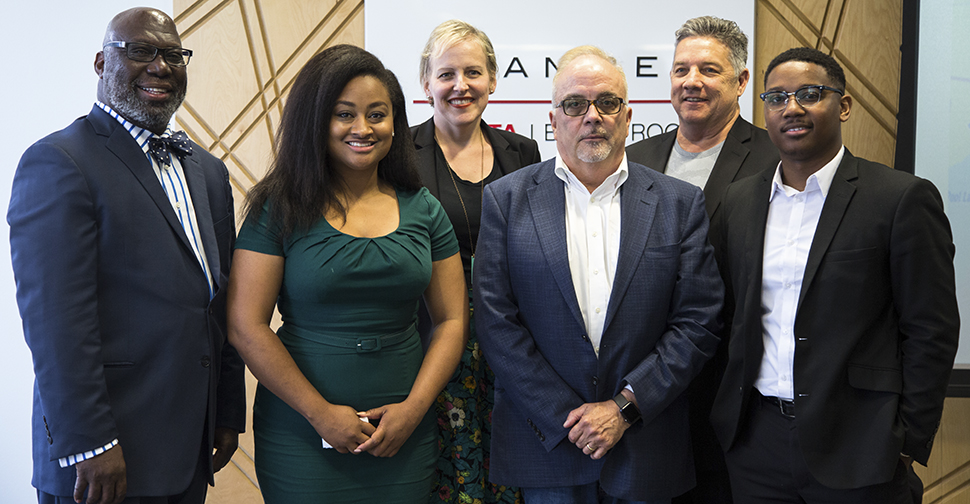
Representatives from co-working/entrepreneur centers gathered recently to describe their progress, strategies, and aspirations for Southern Dallas.
If capitalism could be reconfigured to allow neighbors to become owners of their own unique businesses, what would it look like?
That question is being answered in Southern Dallas, where six co-working/entrepreneur centers are in varying stages of development.
Representatives from the Red Bird Entrepreneur Center, Impact House, GoodWork, the Fair Park Entrepreneur Center (The District), Tyler Station, and the Grow DeSoto Business Incubator gathered on June 15 to describe their progress, strategies, and their aspirations for Southern Dallas.
The panelists all emphasized their overlapping missions, which include improving the quality of workers’ lives, boosting surrounding neighborhoods (where most of them live), while netting a profit (referred to as the “triple bottom line”). They also agreed upon the idea of including existing neighbors and businesses in their work, rather than pushing them out through gentrification.
More than 60 members of the Dallas Regional Chamber converged to get the download as part of the DRC’s Southern Dallas Task Force and Innovation meeting.
“We have many, many little jewels in southern Dallas County,” said Monte Anderson, founder of Tyler Station and Grow DeSoto. “We have many special entrepreneurs who just need an entry point. They just need a lemonade stand, to stand in for a day. I was like that when I got into this business. I had to be on a stand in the street, selling real estate. I couldn’t go to school and learn it, and (to) do a business plan. I needed a place to practice.”
Anderson and his investors purchased and cleared out the 110,000-square-foot former location of Dixie Wax Paper Company in Oak Cliff. The structure is now occupied by a brewery, welders, carpenters, furniture makers, architects, photographers, and other tenants.
The Grow DeSoto Business Incubator, meanwhile, is located at the former Brookhollow Shopping Center in DeSoto, which once housed an Ace Hardware as its anchor tenant. Plans for the redevelopment include restaurants, retail spaces, and a full-service barbershop.
“We had a pitch day last weekend, kind of like a talent show or a ‘Shark Tank,’” Anderson said. “We had 25 slots for entrepreneurs to come in. We didn’t know if they were there. We had 15 leases come to us. How many of you real estate guys would like to have 15 leases come to you?”
Anderson said winners of the competition ranged from children who plan to open their own snowcone and ice cream stands to adults who intend to sell barbecue and Cajun food.
“You don’t create the x-factor from a franchise” Anderson said. “Communities need to be themselves.”
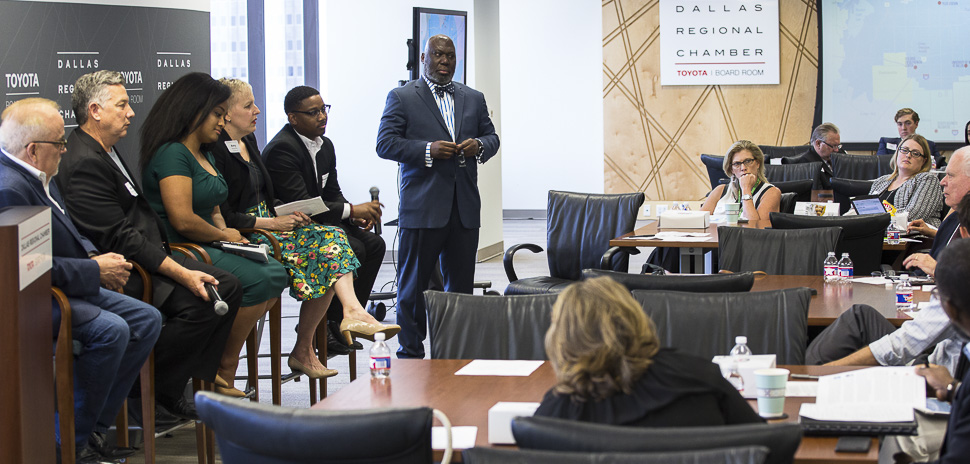
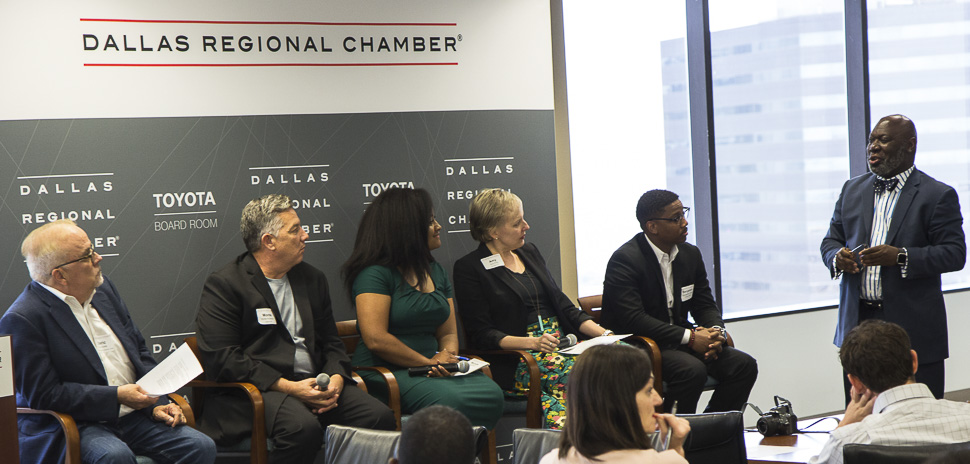
Michelle Williams represented the Red Bird Entrepreneur Center, a collaboration involving the Dallas Entrepreneur Center, the DRC, and the Red Bird Mall redevelopment team. That center will be located at Red Bird Mall and will serve as an incubator and workspace for aspiring entrepreneurs in that part of town.
Williams said from the start, the Red Bird Mall developers have worked with neighbors to incorporate the tools and connections necessary to help their businesses take off. The Red Bird center will serve as a hub of support for affiliated entrepreneur centers at University of North Texas at Dallas and Paul Quinn College, and for other general entrepreneurial efforts in Southern Dallas.
Also working with neighborhood entrepreneurs and professionals is the co-working space GoodWork, represented at the forum by its co-founder, Amy King.
King said GoodWork’s location — in the 1808 building on South Good-Latimer — was perfect for her organization’s mission.
“It is an area that didn’t have much going on,” King said. “It was kind of like tumbleweeds at night. There are a couple dilapidated houses that are left, but the whole area was bisected by I-30. I’ve seen that in so many cities (e.g.), Detroit, Dallas, etc. People are cut off. You get white flight. Now, entrepreneurship is one of the biggest things that’s breaking that cycle. Being able to be the first, we’re kind of the “produce district” — [it’s] the double meaning for ‘produce’ and produce.”
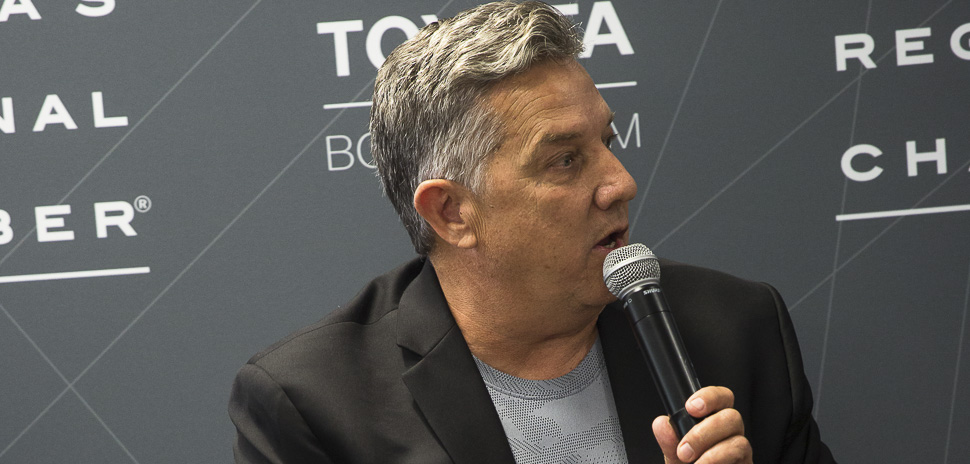
While the Fair Park District Entrepreneur Center (The District) is obtaining financing to refurbish its 5,000 square-foot building near Fair Park, its leader, Doric Earle, has been working with neighbors, business owners, and property owners in its Fair Park neighborhood to establish a community garden.
“What we’re trying to do is to create an economy and environment built for retail, and for living,” Earle said, adding that he and others in his organization will find entrepreneurs within those neighborhoods.
Earle said the zip codes The District is focusing on — 75215 and 75210 — have among the highest child poverty rates in the nation, has nearly 1,000 vacant lots, high incarceration rates, and real estate in sore need of repair and replacement.
“As a day job, I work with the State Fair around gardening, with local folks trying to improve their neighborhood, by building new houses,” Earle said.
“I work with nonprofits, with early childhood education. I’ve got $100 million worth of projects we’re trying to do to rebuild the neighborhoods.”
Impact House, also located in the Fair Park/Exposition Park neighborhood, meanwhile, is set for a July 1 grand opening, and has set its sights on serving as a co-working space, and encouraging small and mid-size businesses to improve their communities.
“I see a lot of major corporations adopting major businesses doing it — you see Starbucks doing it. You see Pepsi do it,” said Benjamin Vann, founder and CEO of Impact House. “We see a lot of the millennial generation coming into the economy, and they don’t see the line between giving back to the community and building wealth.”
Vann said he sees mentorship relationships among established business leaders and budding business people as crucial to building wealth in poor communities.
“If you look at the Dallas stats, we have childhood poverty rates that are the same as in third-world countries,” he said.
“That’s one reason I chose that (Exposition Park/Fair Park) area, because I feel you can’t talk social entrepreneurialism, if you don’t include the voices of the people from the bottom-up level, who are dealing with these challenges.”
The aforementioned ventures join Common Desk and the Kessler Co-Op in Oak Cliff, the Bill J. Priest Institute for Economic Development, and The Cedars Union in the Cedars, in their efforts for providing services and support to entrepreneurs and small businesses in Southern Dallas.
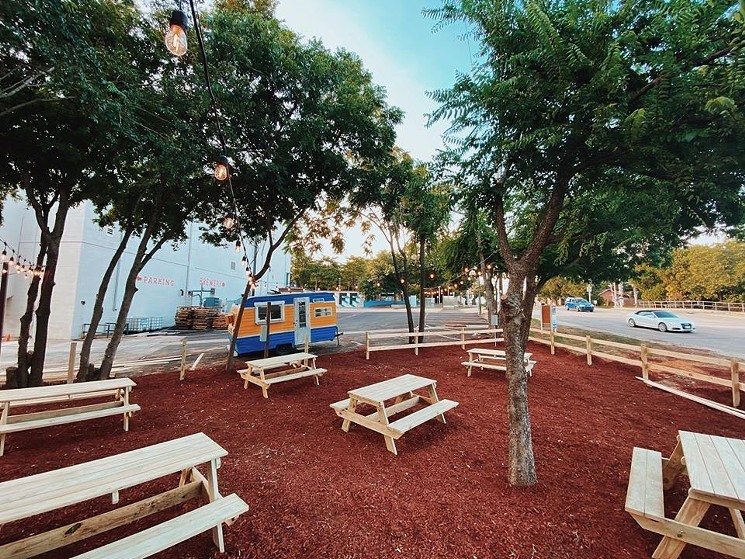
Around the back of this brewery in the Tyler Station and situated over the Elmwood Branch of Cedar Creek, this garden has picnic tables, shade trees and an old snow-cone trailer full of beer kegs. A taco trailer has taken up residence, too, which means that if you want to have a few pints on a weekend, there’s no reason to leave. In its early days, Oak Cliff specialized in hazy IPAs and fruited sours, and its most popular offerings now are a series of brews inspired by paleta flavors. But there are good offerings for normcore drinkers, too, like an outstanding pilsner (Bounced Czech) and a Goldilocks-style just-right blended pour called John Hancock, which mixes together the rather sweet light lager and rather bitter dark lager in one perfect cup.
Oak Cliff/South Dallas 214-506-0480 https://oakcliffbrewing.com/
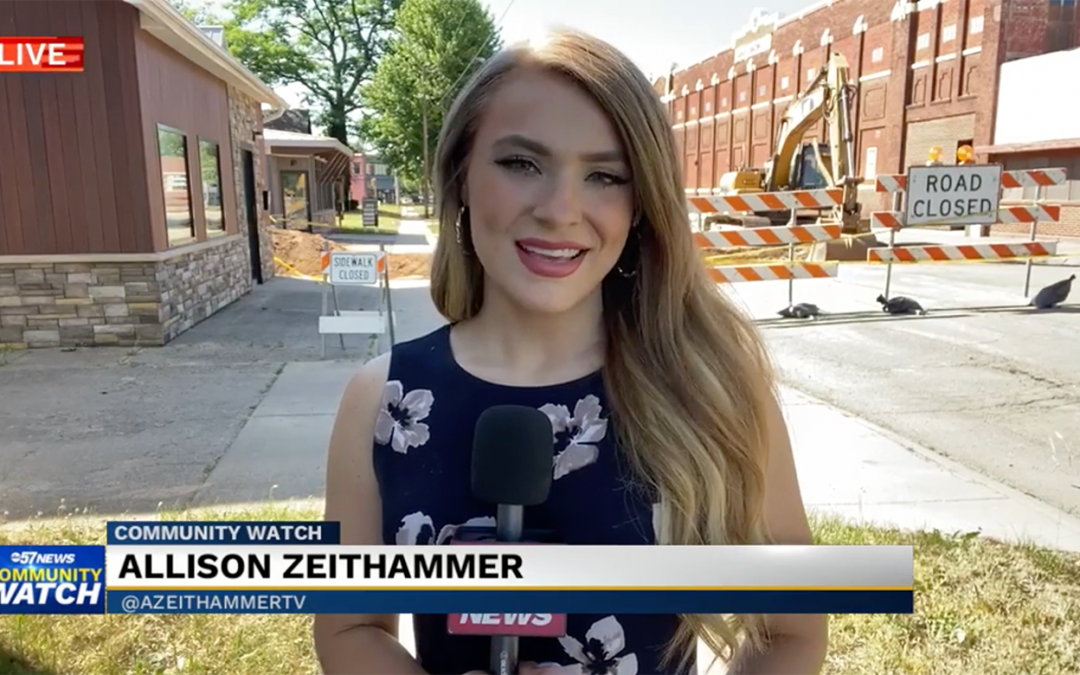
ABC57
The Ward Baking Company located on the corner of Rex Street and Portage Avenue, has sat crumbling and empty for close to 10 years. Needless to say, it holds a lot of history.
“This was built originally when it was at the edge of the city as the ward baking company and originally it was just a small German bakery called the Beuse Bakery and then they bought that up, added another building in the 1940s,” Bakery Group LLC President Mike Keen said. “And then it was abandoned in 2012 and since then it’s just sat empty full of stuff.”
A few years after it was abandoned, the Near Northwest Neighborhood Community Center tried to turn the building into affordable elderly and workforce housing, but were never able to win the grant needed to make it happen.
“The thing has been a neighborhood nuisance for the last decade, plus driving down neighborhood property values and making people feel this isn’t a very attractive neighborhood,” Keen said.
So, two years ago in 2019, Bakery Group LLC President Mike Keen stepped up to the plate, dedicating tons of time and brainstorming, to bring life back to the building and to the area!
“We want to turn it into neighborhood asset so that it becomes a draw because it’s such a beautiful building and if we can bring it back to its earlier life, it’ll be one of the coolest spaces not only in South Bend but really in the region,” Keen said.
“I sure do hope it does give people an opportunity to give it a second look at the near north side and portage corridor,” South Bend Chamber of Commerce Executive Vice President Rob DeCleene said.
Last night, Keen and the South Bend Common Council met to discuss ways the city can help financially, and approved two tax abatements for the development. With this help, the vision for this enormous space, is that much closer to becoming a reality!
“What we are looking for is a broad variety. We want some really creative folks, the artists and the makers, but we also want some professional office folks, you know people who can provide services to the other people in the building but also the neighborhood.”
“I think anytime you can use a building anywhere in the city that’s of that size with that much street frontage, it’s just an exciting opportunity for guests, for the city, and the neighborhood surrounding it,” DeCleene said.
What the future holds for the building down the line, and what it’ll bring to the table, is what Keen calls a complete transformation.
“We’ve been working for the last couple of decades to sort of rebuild the neighborhood, there have been many vacant lots that we’ve recently purchased maybe 15 or 16,” Keen said. “But to go from a neighborhood that people sort of see as a scary neighborhood to a place where it becomes a destination that people want to come around and hangout and be part of, it really is, what I say is transformational.”
Keen said the transformation hopefully begins next year, and estimates it to be a 3-year project. In the meantime, he’s on the lookout for local businesses who are interested in rent out one of the 60 units inside when it’s done. If you’re interested in collaborating, you can reach out to him at mfkeen1@gmail.com.
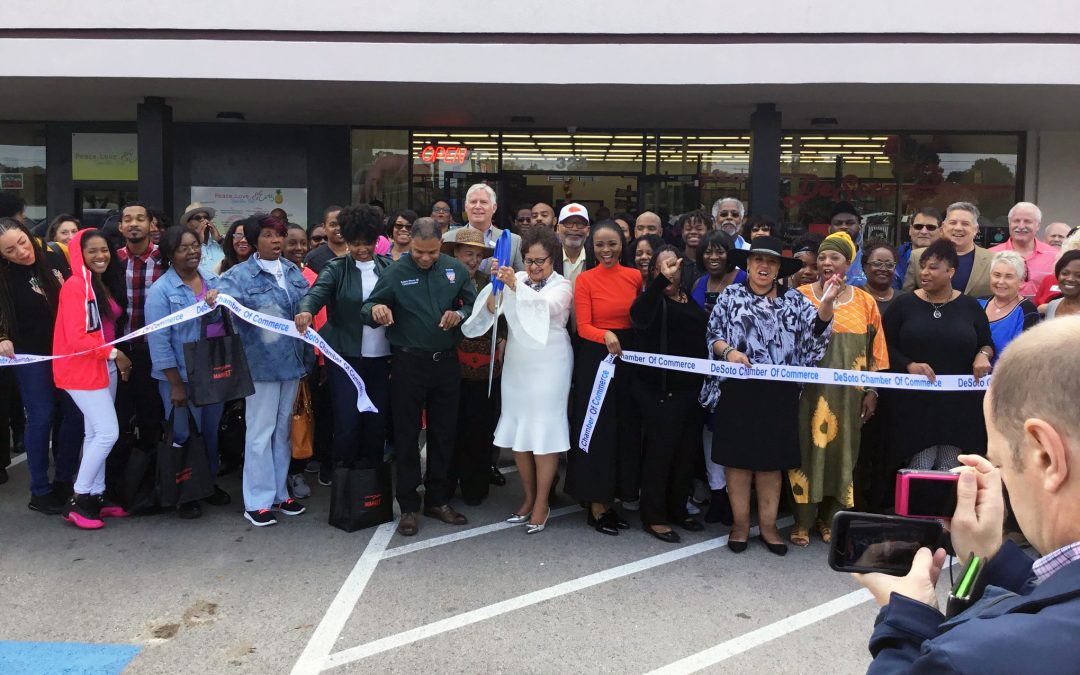
Big Award & New Successes for Public-Private Partnership Between DeSoto Economic Development Corporation, City of DeSoto, Options Real Estate, and The Industry Hub Boost Shuttered Hardware Store Turned Market & Small Business Incubator.
At one time the future of the large shopping center on Belt Line Road in DeSoto, Texas looked bleak. Their anchor tenant, a 26,000 square foot Ace Hardware Store shut down, and the only option to some was to bring in a dollar store. But City Leaders, their Economic Development Corporation, and forward thinking civic allies teamed up to oppose the dollar store option and, instead, proposed the idea of a market place for merchants with unique items and services and that could also act a small business incubator to “grow” the next generation of DeSoto’s businesses.
Back on June 14, 2019, The North Central Texas Council of Governments (NCTCOG), an association of North Texas governments that assists with regional planning efforts, awarded their Celebrating Leadership in Development Excellence (CLIDE) Award for New Development to the DeSoto Market Place for exemplifying one or more of their Principles of Development Excellence. They also declared that the DeSoto Market Place serves as an example of Development Excellence in the North Central Texas Region. And since then the Market Place has welcomed a Vietnamese Restaurant the has elevated DeSoto’s culinary landscape and seen one incubator tenant build on their success and venture out into DeSoto’s business community.
The CLIDE Awards Program, created in 2003, recognizes public and private entities including cities, developers, architects, planners and engineers, to encourage innovative development projects and practices that will help accommodate expected growth and ensure a sustainable North Texas for generations to come.
The DeSoto Market Place houses the Grow DeSoto Market Place (Grow DeSoto) which came to fruition from a first of its kind public-private partnership between the DeSoto Economic Development Corporation (DeSoto EDC), the City of DeSoto, Options Real Estate, and The Industry Hub to repurpose a building once occupied by ACE Hardware in a manner that would benefit small business owners, as well as the community of DeSoto.
The vision of this unique partnership is to provide a lower barrier to entry on the path to entrepreneurship for small business owners. Businesses that lease space within the Grow DeSoto Market Place receive reduced rental rates with all utilities included, a high traffic area that is easily accessible from I-35 and I-20, flexible lease terms, ongoing business training, mentorship, and the resource assistance of the DeSoto EDC, the DeSoto Chamber of Commerce, the City of DeSoto, Options Real Estate, and The Industry HUB. The space also includes private office suites that are available for lease.
Grow DeSoto, which celebrated its grand opening in October 2018, provides shoppers in DeSoto and the region with a wide variety of unique retail shops, services, restaurants, and a full service fitness and rehabilitation center. “The Grow DeSoto Market Place symbolizes the creative rebirth of our small business community and serves as an example to many other cities that the closure of old businesses in a community can present bold new opportunities that can ultimately make a positive difference within a city!” stated DeSoto Mayor Curtistene McCowan. Monte Anderson, CEO of Options Real Estate, added “As I had expected, we have found highly skilled and creative entrepreneurs from the local community. And, at the same time, we recognize that there is still a lot of work to do in developing local entrepreneurs.”
The DeSoto Economic Development Corporation (DeSoto EDC) is a non-profit organization funded by sales tax revenue to foster local prosperity while maintaining an excellent quality of life and minimizing local ad valorem taxation. The DeSoto EDC aims to assist businesses with a seamless relocation assistance process to DeSoto by providing site selection searches, competitive incentives, a skilled workforce and a prime location in the Dallas/Fort Worth metroplex. Whether your company needs a new commercial office building on Interstate 35, a manufacturing facility on a hill overlooking downtown Dallas, a fulfillment warehouse, or a service-oriented facility, DeSoto is the place to build your business, raise your kids, enjoy life and retire in style. For more information, visit our website at http://www.dedc.org.
For more information about the Grow DeSoto Market Place visit http://www.growdesoto.org
For more information about the CLIDE Award for New Development visit http://www.developmentexcellence.com
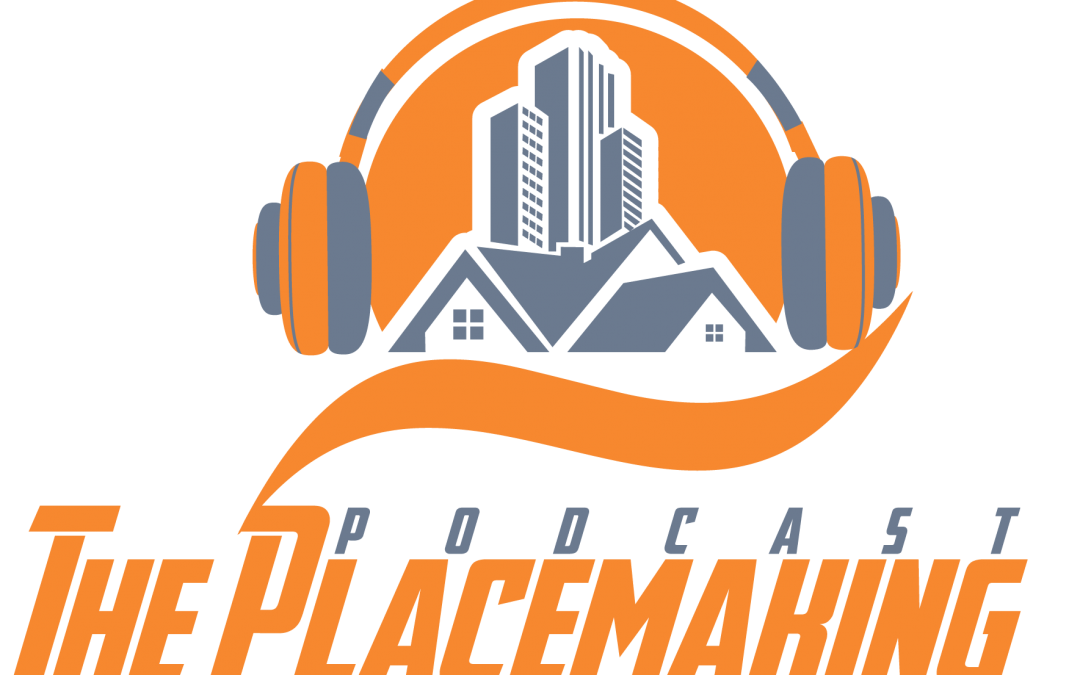
Building Better Neighborhoods
Through Incremental Development
I am extremely excited to share this next conversation with all of you. Monte Anderson is the President of Options Real Estate a multi-service real estate company specializing in creating sustainable neighborhoods in southern Dallas and northern Ellis counties in Texas. Monte began his real estate career in 1984 and since that time has concentrated solely on improving the living and working environments in these communities where he was born and raised. Monte is an outspoken and frequently recognized advocate for policies and practice to serve urban neighborhoods. He currently focuses his development practice in three areas in North Texas: the southern neighborhoods of the city of Dallas, the first ring suburb of Duncanville and exurban town of Midlothian.
Options Real Estate was founded in October of 1991 as a full service commercial real estate company specializing in Southern Dallas County with one mission in mind: To make their neighborhoods and business owners better through the built environment. Their team believes in enhancing the quality of life of Southern Dallas & Northern Ellis Counties and advancing its image, in order to provide an enduring inheritance to future generations. They hope to build a community where residents can enjoy educational and employment opportunities that utilize the technologies of the 21st century, find cultural and spiritual fulfillment, and have a diversity of OPTIONS for shopping, dining, entertainment, living, or homes.
In this episode, we are going to discuss the importance of finding and cultivating your own territory or “farm”, how to raise capital for your next real estate development deal, and what it truly means to be an incremental developer. There is loads of great information in this episode and I greatly appreciated Monte for taking the time out of his extremely busy schedule to discuss this topic of improving communities through the use of incremental development with me.
As always, if you have enjoyed the show, please subscribe to the show and share it with your friends in the industry. There will be more exciting conversations on the shows to come.
This was another fun episode to record. I hate to pick favorites because it is so hard to do, but this one is up there as one of my favorite episodes to record. I thoroughly enjoyed Monte candidly sharing his story as well as the story of the Options Real Estate. Monte really provided some great inspiration for those looking to get into development but may not know how to get in to development. He showed through his story that anybody really can get into development. Even someone whose job is to pick up trash in a parking lot. There were so many great talking points that Monte made throughout the discussion, so it is hard to just pick three for my main take-away’s this week. The following main topics of the show come from an understanding of incremental development that Monte possesses.
1. Finding and Cultivating your “Farm”
2. How to Develop Incrementally out of Necessity.
3. Don’t chase money. Let money chase you.
As always, I will dig into each of these “take-aways” every week on the blog. So, without further a due, here we go!
Monte provided so many great analogies during the course of our discussion to better paint a picture of what he is doing in south Dallas. One of the comparisons made was of the area he consistently “cultivated” for development to a farm. This is not hard to conceive visually. He is constantly tending to his farm by planting seeds of development throughout south Dallas. These seeds grow and produce future real estate investors and entrepreneurs that then plant more seeds in the surrounding communities.
He is constantly monitoring the “farm” as part of his day-to-day activities. This allows him to quickly notice a need or “weed” growing in the community. He can then plant a seed to fill the need in the community. Or he can remove a weed or poor-performing asset that is bringing down the values in the surrounding community. This analogy is all too perfect when you begin to dig deeper into the meaning behind it.
As Monte mentioned, the way he truly is able to provide value in the community in which he’s a part, he really needed to focus on one or two areas. This allowed him to be in tune with the opportunities available and built trust in the surrounding community. People in south Dallas and north Ellis county know that a project that Monte is working on will get done right and he will deliver on his promises. This type of trust takes time and requires effort tending to the farm, but when it is achieved, the fruit that is produced from this effort is all too sweet.
Incremental development is a concentrated, small-scale method of development that improves the surrounding community in a nutshell. Monte was doing this type of development before it was even cool. As mentioned in the show, he was doing this out of necessity, not necessarily because he wanted to. After a few successful incremental developments, Monte began to see the value that he could create with a little amount of starting capital and some sweat equity.
The first case study from my discussion with Monte was on a 16-acre site that he rezoned and subdivided. You may say that this doesn’t seem that incremental, but this was not a project that he completed all at once. He phased the development in such a way that he could adapt to market shifts as well as not in a way that would overextend his small business. The next project we discussed was the Belmont Hotel. This is where he first noticed the power of incremental development. By updating and upgrading the hotel one room at a time, Monte was able to make the Belmont Hotel truly a world-class destination. The upgrades were more organic in nature and did not require large sums of capital to do so one room at a time. He then rolled over the profits from the increased rental rates received from the upgraded rooms into the next one.
The theory and practice behind incremental development is truly empowering for those individuals that would like to get into development but believe that a lack of capital is the barrier to their success in development. By the process of incremental development, one can change this perceived barrier into an asset by creating truly special places through the use of creativity. This process of incremental development allows truly anyone to become a developer and improve their surrounding communities if they have the drive and are willing to be creative.
This last main point is one that is almost too simple, but often overlooked by those in the real estate industry. Monte provided an analogy that was all too perfect to explain this last point. He takes us to a time when we all had a crush. We wouldn’t chase after them, because that would turn them away as it makes you look desperate. We would “act cool” and act like we weren’t attracted to them and hope that this makes them desire you more. The same goes for money or capital in Monte’s opinion.
He mentions that the best way to approach banks is to do your due diligence and request to “interview” the loan officers in charge of the various branch. Do not come to the bank at the last minute hoping for pity. Build relationships with the bankers early and show them that you are highly competent and have options for which to borrow money. This will go a long way in your ability to obtain capital for projects that you have upcoming. I have to admit, Monte provided tons of practical knowledge and inspired me to look at even more projects in the community in a way that I hadn’t originally.
As you can see from the takeaways above, this podcast episode was absolutely full of great information on making it in real estate development and the benefits of incremental development in building better neighborhoods. If you have enjoyed the content and the show, please subscribe to the show below and share it with your friends in the industry! We’ll have many more great discussions on the shows to come.
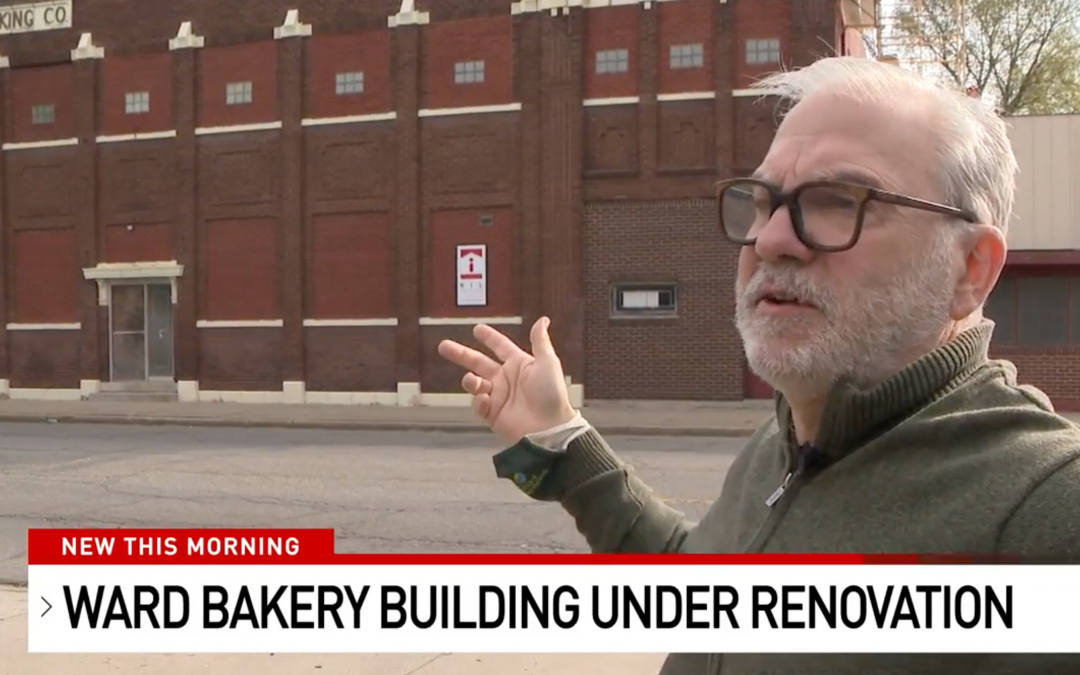
WSBT 22